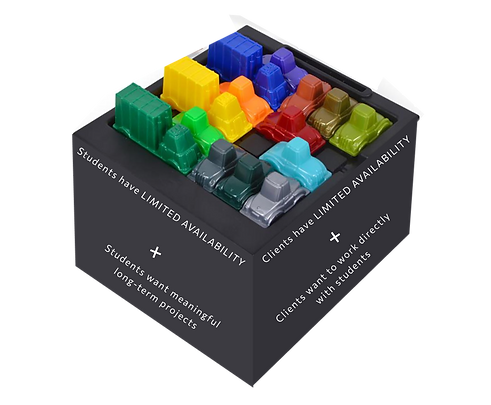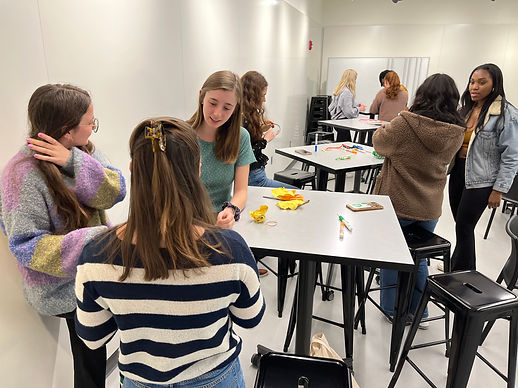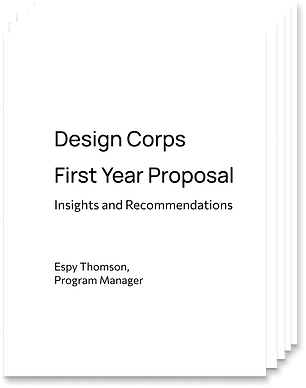
Design Corps
Redesigning Dartmouth College’s services through student designers
Problem Overview
Dartmouth College is a private university that offers a wide array of student services and opportunities through its 40+ academic departments, and 75 centers and institutes. Many directors of campus organizations and centers reported that they were not confident their offerings meet the needs of the student body. At the same time, students who took Dartmouth’s human-centered design classes sought more opportunities to use their creative problem-solving skills.
A new initiative called the Design Initiative At Dartmouth (DIAD) launched the idea for a program to address this problem. Design Corps would pair teams of Dartmouth student designers with campus organizations to work on a key problem each organization faced. While the students were solving design problems, I would coach their work and design the design program itself. My challenge was to create and implement this service design program to meet everyone’s needs in an effective and strategic way.
My Role
Service Designer, Program Manager
Team Size
Two
Skills
Service design, design research, program design and management, copywriting
Deliverables
Prototyped service design program, program website, solutions offered to 6 client organizations
How might we maximize the experience and benefits of the Design Corps program for students and client organizations alike?
Outcome: program and projects
We developed a service design program that employed more than 30 students who provided creative solutions to 6 Dartmouth College organization partners. We then identified and proposed new iterations of the program so that it would better suit students’ and client organizations’ needs.
2021 - 2022 Design Corps Projects and Project Partners
My Process

Secondary Research, build relationships, user interviews
HMWS, define success criteria, coding and bucketing
Design system, implement and test it
Pre-Prototype Research
Understanding the Context of the Design Corps Idea
When I began working on this project, the idea of Design Corps had been proposed, but not developed. 5 initial (a 6th was added later) campus project partners and 20 students designers had been selected for the trial program, but there was no framework for how the program itself might be carried out. Therefore,
I researched student work-study programs at Dartmouth and at other universities and found that there were 0 similar service design programs

I interviewed the 20 student Design Corps members and 5 client partners before the start of the program to determine their goals and needs from the Design Corps program and staff team
_edited.png)
I reviewed the introductory human-centered design class offered at Dartmouth and saw that the students worked on brief theoretical projects without actual clients
Synthesis
Insights From Initial Research
From the initial research, it became apparent that the Dartmouth student and staff bodies are incredibly over-scheduled, and grouping teams of 4-5 students together to work on a project with 1 - 4 staff members was a complex game of Traffic Jam. Therefore, I focused my program development efforts on creating a schedule that would work for everyone.
.png)
Scheduling Design Corps with Dartmouth students and clients
Design Solution #1
Design Solution #2
Create a year-long design project structure where students are able to work for fewer hours over the course of 3 quarters and not rush to finish a project before they form meaningful relationships
Only meet with project partners once a term (every 10-weeks) and let the students work with clients more frequently
Prototype
First Year of Design Corps
We paired 5 Design Corps teams with 5 campus organizations. I then developed a preliminary program structure that involved student workshops and cohort meetings every three weeks and Design Corps staff meetings with the project partners at the end of every term. I also created a timeline of suggested deadlines for project deliverables for each of the 5 projects, working off the feedback that students generally preferred flexible deadlines.


Post-Prototype Reflection and Research
Should the Design Corps Program Exist and Does it Meet Student and Client needs?
Halfway through the first year, we began reassessing the program. Design Corps existed to provide student designers with an opportunity to improve Dartmouth’s services and for those service directors to get help with complex problems they faced. However, it was not yet clear that the program in its current format was the solution to these challenges.
Research goals: Understand if Design Corps is meeting its purpose
1) Define success for a Design Corps project--effective, meaningful, productive
2) Assess effort vs. impact for the program
Design Research Techniques:
One on one Interviews with students
Focus Groups
Interviews with client partners and their staff
Coding and Bucketing

Synthesis
Program Pain Points and Design Solutions
From the research conducted, some key issues with the current structure of the program arose.
Pain Points
Design Solutions
Clients Did Not Understand the Student Process
Without Design Thinking experience, clients were often confused by the methods and activities that students wanted to undertake.
Introduction to Design Thinking Workshops
Hosting introductory workshops for prospective clients prior to the selection of client projects would be an education and recruitment technique.
Some Client Problems Were Not Student-Centered
The benefits of using students to inform service delivery were not maximized, leading to frustration and ineffectiveness.
Select Client Problems that Students are Uniquely Suited to Solve
The client problems that were most successful focused on services that students were uniquely situated to solve through their identities and experiences as students using those services.
Students’ Schedules Affected Project Completion
Dartmouth's quarter system made it difficult for students to commit to a schedule far in advance. Students also had time management challenges with longer-term projects.
More Flexible and Shorter Program Commitment
By changing the project length to 1 - 2 quarters with the option to extend it to 3 for further implementation, the program would better meet students’ skills and client needs.
Students Lacked Client Management Skills
Students were not sure how to behave professionally and manage clients when the clients were not clear about what they wanted.
Weekly Student Meetings
Students could be better supported with their relationships by requiring them to meet every week for workshops or communal work time.
We decided to test whether the program could run on a tighter timeframe and still be effective, meaningful, and productive for students and clients. The Frank J. Guarini Institute for International Education approached us because they sought to understand the declining trend of students studying abroad and how they could improve their programmatic offerings. We partnered them with a team of Design Corps students to research this challenge over a 6-week period.
Prototype
Second Iteration of Design Corps: Client #6
Takeaways
We are able to implement this program on a shorter time frame. Not only was the Guarini Institute pleased by the results of the research, but they made changes to their study abroad offerings based on the students’ presentations.
The students also felt like they were able to do meaningful work and fully commit to the project on a shorter time frame.

Research from Guarini Institute Design Corps Team
Reflection
Impact in Year One, Next Steps, and Takeaways
“It's been an incredible opportunity working with fellow designers to bring meaningful change to the Dartmouth student experience."
– Student Member of Design Corps
“I really loved our [student] team and was impressed with their creativity, amazing positivity, professionalism, and stick-to-itiveness.”– Project Partner Organization
Next Steps
After my second round of research, I was gratified to realize that this program was meaningful for both students and client partners and the effort of running it was worth the impact it was having. Rather than ending the program, Design Corps will continue on next year with more student-centered client challenges, different meeting and deadline formats, and continued attention to tinkering and improvement.
Takeaways
The importance of seeking feedback: We were not sure if the program was offering anything beneficial to either the students or the client partners. Rather than waiting in the dark, I undertook the design process to learn how the program was impacting its users.
Not getting attached to solutions: after putting a year of effort and money into an idea, there is a propensity not to reassess the idea. However, I also learned that assessing whether your solution is actively meeting your users’ needs is an essential next step. Iterating the project and actively seeking improvement opportunities are what will bring it closest to being useful for those using it.
Start-up work requires flexibility: Creating this program with a team of two was similar to working in a startup. I had to wear a number of hats and creatively and enthusiastically develop ideas when we faced budgeting, staffing, and scheduling challenges.
I firmly believe that users of services should be the voices to help shape those services. Following that thinking, I also believe that students have immense creativity and should be given a platform to help shape the offerings for other students at Dartmouth College. Working on this project left me deeply inspired by the students and faculty I worked with. Thank you to everyone and particularly Eugene Korsunskiy for helping make this program come to fruition.





